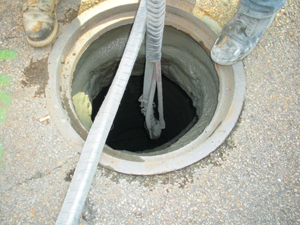Manholes Take Center Stage in Chicago

The ongoing effort to save them before they fall apart is currently the world’s largest manhole rehabilitation effort — with $60 million budgeted for the initial phases. Chicago began the project four years ago and is now rehabilitating thousands of manholes annually.
Replace or Rehabilitate?
Given the scale of the Chicago project, choosing the most effective method of repair was of critical importance. The city commissioned a study of the subject and rehabilitation, as opposed to replacement, was found to be more cost-effective and significantly less disruptive.
However, much depended on the mortar used to reline manholes and how thickly it could be applied. Factors analyzed included mortar strength, soils, compaction, static and dynamic loading, groundwater pressure, diameter and depth and overall manhole condition. After this detailed analysis, the engineers set three specifications for the mortar:
- Minimum of 3,000 psi compressive strength in the first 24 hours after application
- Minimum of 150,000 psi modulus of elasticity in the first 24 hours after application
- Density of material sufficient to prevent water migration
Mortar with these qualities is much different than ordinary Portland cement—in fact, 0.5-in. of such material is about equal to 5 in. of Portland cement.
To determine the actual thickness needed, engineers evaluated the effect of wheel loads from light and heavy traffic (wheel loads affect mainly the top 2 ft of the manhole chimney) and hydrostatic loads from external ground pressures. Calculations showed that for most manhole sizes, a 1- to 2-in. layer of mortar would be sufficient to strengthen, seal and protect each manhole, giving them approximately the lifespan of a new structure.
A variety of cementitious products were evaluated and Permacast MS 10,000 made by AP/M Permaform was selected for all manhole and catch basin relining. MS 10,000 is an ultra high-strength mortar based on Portland cement and fortified with micro silica and other densifying agents. Graded quartz sands and fibers are added to improve cohesion and flexural strength.
What about MIC?
Mortar strength was not the only the only thing to consider when rehabilitating Chicago’s manholes — the proposed solution also had to resist microbiologically-induced concrete corrosion, or MIC.
Poorly understood when the manholes were originally built, MIC is now known to be a prime cause of concrete deterioration in both storm water and wastewater systems. The organic waste, combined with increased temperatures, long retention times, turbulence, and anaerobic conditions create hydrogen sulfide gas. This in turn creates a proliferation of thiobacillus, a bacterium that feeds on the sulfur within the gas and then excretes sulfuric acid. And sulfuric acid, of course, attacks the concrete matrix and decomposes it into a crumbly white mass consisting primarily of gypsum.
To further enhance MS 10,000’s corrosion resistance, city engineers specified the use of ConmicShield, a liquid admixture also made by AP/M Permaform. This material, a water-stabilized silica salt, is a liquid added during the mixing phase that bonds molecularly with cement particles, forming a physical barrier to production of thiobacillus. It is non-toxic to humans and animals, but permanently inhibits single-celled organisms like thiobacillus.
For additional protection against industrial acids and road salts, the city specified a final layer of epoxy on top of the ConmicShield-enhanced MS 10,000. The epoxy-coated, cement-reinforced manholes represent the state-of-the-art in manhole rehabilitation and are expected to last another 100 years.
Application
Manholes are tight spaces, and brick-and-block walls are very irregular, with sizeable voids and protrusions. Many spray techniques use too much pressure, so material rebounds and doesn’t adhere well, and it’s hard to coat brick-and-block thoroughly because spray cannot get into or behind irregularities.
To avoid these problems, Benchmark Construction — the winning bidder for all contracts to date — uses the AP/M Permaform Spin Caster. The Spin Caster is a pump connected to a spinning, mortar-emitting nozzle that is winched in and out of manholes by a rig that two crewmembers can operate. The nozzle spins alternately, clockwise then counter-clockwise, applying half the thickness in each direction.

Application is straightforward and only requires a two-person crew — one to mix mortar and tend the pump and one to operate the winch and spinning nozzle. The Spin Caster quickly applies very thin coats as it is winched up and down. This allows precisely-engineered thicknesses of new material and, depending on the condition of the manhole substrate, allows the crew to move quickly and rehabilitate several manholes per day. Since the nozzle is lowered from the surface, and since hand troweling is usually eliminated, technicians are usually able to stay out of hazardous confined sewer spaces. The combination of thorough coverage, speed and safety made the Spin Caster a winning choice for both Benchmark Construction and the City of Chicago.
Time and corrosion are formidable foes, but Chicago’s massive effort is overcoming both. The world’s largest manhole rehabilitation project is proving that the right mortar, combined with the right MIC protection agent and the proper application methods, is the most cost-effective method of increasing the life of aging manholes and catch basins.
Angus W. Stocking, L.S., is a licensed land surveyor, with 17 years experience in several states, who now writes about construction and infrastructure.
